Stretch marks, or striae gravidarum to use the correct term, are a common problem for both men and women, affecting up to 70% of women and 40% of men. They generally appear on the stomach, thighs, hips, lower back, breasts, buttocks and upper arms. The general reason is due to physical changes to the body, such as pregnancy, a sudden change of weight or muscle mass, or a growth spurt during adolescence. Less common is the use of corticosteroids, or a medical condition, for instance Cushing’s syndrome.
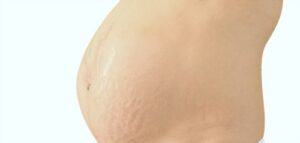 It is estimated that approximately 90% of expectant mothers will experience some stretch marks. Whilst some prevention is possible by making sure that the stretched skin during pregnancy is well hydrated, drinking lots of water and eating a healthy diet, stretch marks are also hereditary so regardless of efforts made, unfortunately if either of your parents had them then it’s likely that you will too!
It is estimated that approximately 90% of expectant mothers will experience some stretch marks. Whilst some prevention is possible by making sure that the stretched skin during pregnancy is well hydrated, drinking lots of water and eating a healthy diet, stretch marks are also hereditary so regardless of efforts made, unfortunately if either of your parents had them then it’s likely that you will too!
The dermis (the middle layer of skin), has strong fibers which allow the skin to stretch as the body changes in shape for whichever reason. However eventually collagen and elastin fibers in the dermis are stretched to the point of tearing, which causes these parallel lines to appear on the skin, which we know as stretch marks.
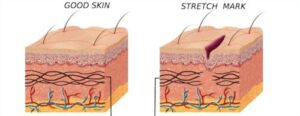
As the stretch mark starts to form, and this process does not happen overnight although the signs are often ignored or overlooked, the skin may start to feel tight, dry or itchy. A new stretch mark will raised and reddish or purple in color, as the blood vessels under the skin show through, but as the blood vessels become smaller the fat beneath the skin becomes visible instead, and the stretch mark “fades” to silvery white.
One thing you should be aware of, no matter what you see advertised as miracle cures to remove stretch marks, essentially they are scars, and as such are permanent. Overtime they can become less visible, with the color changing first, but this can take years. Notwithstanding, there are ways to make them less noticeable quicker.
 Dermatological procedures such as chemical peels, laser therapy, microdermabrasion, radiofrequency and ultrasound can definitely reduce their appearance, but with a hefty price tag attached. Of course, there are cheaper remedies – creams and lotions. Unfortunately most of these are also full of toxins and unhealthy for the body at large. Ultimately you need something to promote elasticity and cell regeneration, so consider natural oils as a home remedy.
Dermatological procedures such as chemical peels, laser therapy, microdermabrasion, radiofrequency and ultrasound can definitely reduce their appearance, but with a hefty price tag attached. Of course, there are cheaper remedies – creams and lotions. Unfortunately most of these are also full of toxins and unhealthy for the body at large. Ultimately you need something to promote elasticity and cell regeneration, so consider natural oils as a home remedy.
Natural oils really are fully equipped for the task. Jam packed with essential fatty acids, vitamins, minerals and nutrients, they posses active compounds with anti-inflammatory, antioxidant, healing, repairing and regenerating properties. They can help to boost collagen and elastin production, improve microcirculation, and smooth and tone the skin, thereby enhancing the overall appearance of the skin and diminishing the appearance of stretch marks. Simply pick your favorite and apply at least once a day, massaging into the damaged area.
Here’s our selection of the best oils for this specific job:
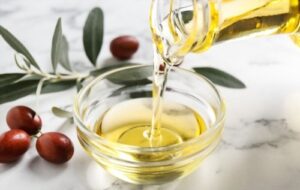 Jojoba Oil
Jojoba Oil
A liquid wax rather than an oil, jojoba oil is very similar to the skin’s own sebum, and has the greatest permeability of all oils, penetrating into the deeper layers of the skin. A natural hydrator, it is hypoallergenic and easily absorbed without leaving a greasy residue. With high concentrates of vitamins E & B complex, plus essential fatty acids, jojoba oil has antioxidant, anti-inflammatory and wound healing properties. With an abundance of proteins it can improve the strength and elasticity of connective tissue, stimulate collagen production and generally increase the regeneration of skin cells.
Retinol is known to demonstrate improvement to early stretch marks, and in a fibroblast scratch test carried out by Vantage, the 24 hour result showed that jojoba was superior in significantly improved wound healing compared to retinol, demonstrating its potential for the healing of stretch marks. Jojoba is also a great choice during pregnancy to hydrate the skin and help to reduce the formation of stretch marks.
 Almond Oil
Almond Oil
Almond oil is rich in vitamin E, plus an impressive amount of other beneficial vitamins, minerals and fatty acids. Hypoallergenic and extremely gentle, it is suitable for all skin types, and perfectly moisturizes dry or undernourished skin. Penetrating easily into the deeper layers of the skin, almond oil, nourishes and repairs, promoting the renewal of skin cells, and stimulating the natural production of collagen and elastin. The skin will appear smoother, toned, more elastic, and brighter, helping to diminish the appearance of stretch marks.
Argan Oil
Argan oil is an abundance of vitamins C, D and E, polyphenols and linoleic acid and other beneficial nutrients, and is easily absorbed into the skin. Potent antioxidant, anti-inflammatory and wound healing properties make this oil indispensable for diminishing the appearance of stretch marks. It will help to buff away impurities and smooth and tone the skin, stimulating the natural production of collagen and elastin, restoring skin firmness and elasticity, smoothing the skin’s surface, and accelerating the process of skin regeneration.
Argan oil improves blood microcirculation in the subcutaneous layer. A 2016 study confirmed that after application of Argan oil on stretchmarks, an ultrasound affirmed that the skin was more elastic, and the authors concluded that it could be helpful in the treatment of stretchmarks and other skin discolorations. A previous study in 2015 on menopausal women had also corroborated the increase of skin elasticity.
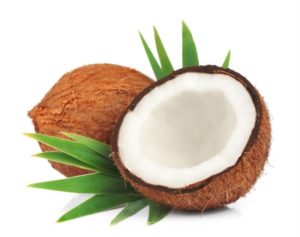 Coconut Oil
Coconut Oil
Coconut oil is full of beneficial vitamins B, C and E, minerals, fatty acids and other skin-loving nutrients, with antioxidant, anti-inflammatory and wound healing properties. It absorbs easily into the skin and provides a protective shield, locking in moisture which is so important for damaged skin. Known for brightening the skin, coconut oil actively encourages collagen production to speed up recovery, and keep the skin supple and elastic and diminish the appearance of stretch marks.
Aloe Vera
Although technically not an oil, we can’t leave this one of this list! Aloe Vera is a natural light moisturizer with incredible hydrating properties and according to studies it can penetrate up to three epidermal layers of the skin, in addition to penetrating the epidermis quicker than water.
Mucopolysaccharides in aloe Vera help to bind moisture into the skin, without blocking the pores or leaving a greasy residue, in fact it has been shown to increase skin repair by up to eight times. By penetrating up to three epidermal layers of the skin, in addition to boosting skin cell regeneration, stimulating collagen and elastin, and improving blood circulation, aloe Vera can effectively help to reduce the appearance of stretch marks.
A few drops of the following essential oils may also be added to any of the above to increase their potency and effectiveness (approx. 6 drops per 20ml):
Patchouli Oil
Patchouli is known to promote collagen synthesis as concluded in an animal study of 2013. It also has astringent properties which is extremely helpful in the restoration of scar tissue. Patchouli oil will promote wound healing and tissue repair, helping to strengthen the skin, encourage new skin growth, and restore skin smoothness, thus improving the appearance of stretch marks.
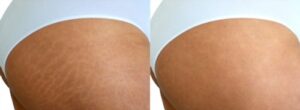 Frankincense Oil
Frankincense Oil
Frankincense oil is known for its positive effect on scar tissue. A 2017 study investigated its effect on fibroblasts (growths of connective tissue) and concluded that frankincense decreased inflammation and seemed to encourage cell-signaling, thus influencing cell repair and regeneration. This oil helps to tighten the skin, and by promoting the growth of new healthy skin tissue can help to address uneven skin tone and diminish the appearance of stretch marks.
Geranium Oil
Geranium oil has powerful cicatrizing, astringent and cell regeneration properties, and is known to accelerate the healing and fading of scars and stretch marks. Geranium oil will tighten and strengthen the epidermis, boost collagen, elastin and cell renewal, and eliminate dead skin cells, totally reviving the skin tone and maintaining smoothness and firmness.
Lavender Oil
Lavender oil stimulates skin microcirculation, and boosts elasticity of the skin. Research in 2016 confirmed that this oil can increase collagen production, shrink wounds and promote the growth of new skin cells. PIC9 This gentle oil can help to strengthen and restore the skin, diminishing the appearance of stretch marks.
Rose Oil
Rose oil has skin regenerating capabilities to reduce the appearance of stretch marks. It enhances blood circulation, strengthens and stimulates skin cells, promoting collagen production and skin regeneration, and increases the skin’s permeability, ensuring that more healthy nutrients may be absorbed. Rose oil will also help to maintain the moisture balance in the skin.
One final word on stretch marks – they are natural and common and should not be a source of embarrassment. They cannot be totally diminished, although they can be made less visible, but this will not happen overnight. In the meanwhile, embrace these scars – they tell the story of your journey through life.


